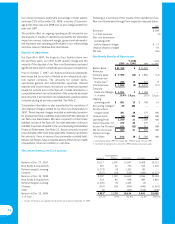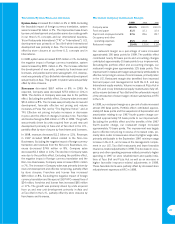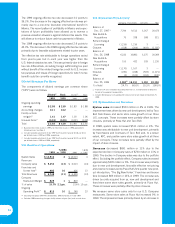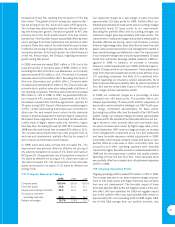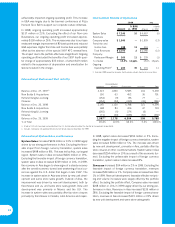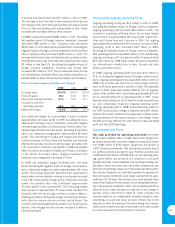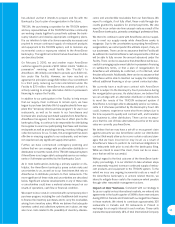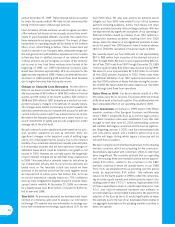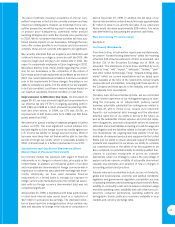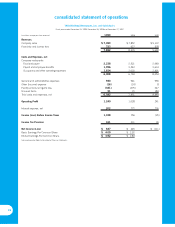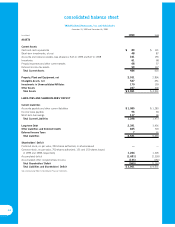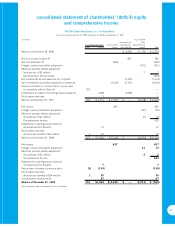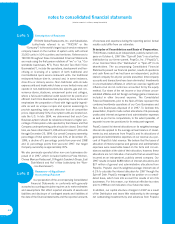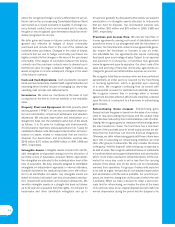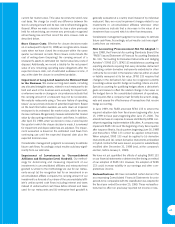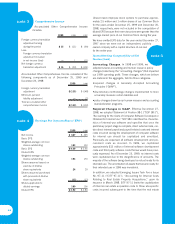Pizza Hut 1999 Annual Report Download - page 38
Download and view the complete annual report
Please find page 38 of the 1999 Pizza Hut annual report below. You can navigate through the pages in the report by either clicking on the pages listed below, or by using the keyword search tool below to find specific information within the annual report.
units at December 25, 1999. These interests will be accounted
for under the equity method. We have not yet determined the
timing of the formation of these new ventures.
Upon formation of these ventures, we will recognize our share
of the ventures’ net income or loss as equity income from invest-
ments in unconsolidated affiliates. Currently, the results from
these restaurants are being consolidated. The impact of these
transactions on operating results will be similar to the portfolio
effect of our refranchising activities. These transactions will
result in a decline in our Company sales, restaurant margin dol-
lars and general and administrative expenses and an increase
in franchise fees. In addition, because of our retained interest
in these ventures, we will recognize our share of the ventures’
net income or loss. Had these ventures been formed at the
beginning of 1999, our 1999 International Company sales
would have declined approximately 14% as compared to the
slight increase reported in 1999. However, we estimate the over-
all impact on 1999 operating profit would have been favorable
due to higher franchise fees and equity income.
Change in Casualty Loss Estimates. As described in
Note 21, we have recorded favorable adjustments to our casu-
alty loss reserves of $30 million in 1999 ($21 million in the first
quarter and $9 million in the fourth quarter), $23 million in
1998 and $18 million in 1997 primarily as a result of our inde-
pendent actuary’s changes in its estimate of casualty losses.
The changes were related to previously recorded casualty loss
estimates determined by our independent actuary for both the
current and prior years in which we retained some risk of loss.
We believe the favorable adjustments are a direct result of our
recent investments in safety and security programs to better
manage risk at the store level.
We will continue to make adjustments both based on our actu-
ary’s periodic valuations as well as whenever there are
significant changes in the expected costs of settling large
claims not contemplated by the actuary. Due to the inherent
volatility of our actuarially-determined casualty loss estimates,
it is reasonably possible that we will experience changes in
estimated losses which could be material to our growth in net
income in 2000. However, we currently expect the magnitude
of such estimate changes will be less than those experienced
in 1999. This expectation is primarily based on indications by
our independent actuary that its current loss estimates are
based more on the favorable actual loss trends we have
achieved in the last few years than the more negative trends
we experienced in earlier years. We believe that, since we
record our reserves for casualty losses at a 75% confidence
level, we have mitigated the negative impact of adverse devel-
opment and/or volatility. At December 25, 1999, our reserves
for casualty losses were $142 million, compared to $154 mil-
lion at year-end 1998.
Year 2000. As previously disclosed, we developed and imple-
mented an enterprise-wide plan to prepare our information
technology (IT) systems and non-information technology sys-
tems with embedded technology applications (ET) for the
Year 2000 issue. We also took actions we believed would
mitigate our Year 2000 risks related to our critical business
partners including suppliers, banks, franchisees and other
service providers (primarily data exchange partners). We have
not experienced any significant disruptions of our operating or
financial activities caused by a failure of our IT/ET systems or
unexpected business problems resulting from Year 2000
issues. Given the absence of any significant problems to date,
we do not expect Year 2000 issues to have a material adverse
effect on TRICON’s operations or financial results in 2000.
We currently expect our Year 2000 plan to cost approximately
$67 to $68 million from inception of the planned actions in
1997 through 2000. We have incurred approximately $65 mil-
lion of Year 2000 costs from 1997 through December 25, 1999
of which approximately $30 million was incurred during 1999.
We expect to incur approximately $2 to $3 million to complete
all Year 2000 problem resolution in 2000. These costs relate
to additional validation of our IT/ET systems and resolution of
any Year 2000 problems or issues that arise during the remain-
der of 2000. We have funded the costs related to our Year 2000
plan through cash flows from operations.
Extra Week in 2000. Our fiscal calendar results in a fifty-
third week every five or six years. Fiscal year 2000 will include
a fifty-third week in the fourth quarter. This additional week will
have a favorable effect on our operating results for 2000.
Euro Conversion. On January 1, 1999, eleven of the fifteen
member countries of the European Economic and Monetary
Union (“EMU”) adopted the Euro as a common legal currency
and fixed conversion rates were established. From that date
through no later than June 30, 2002, participating countries
will maintain both legacy currencies and the Euro as legal ten-
der. Beginning January 1, 2002, new Euro-denominated bills
and coins will be issued, and a transition period of up to six
months will begin during which legacy currencies will be
removed from circulation.
We have Company and franchised businesses in the adopting
member countries, which are preparing for the conversion.
Expenditures associated with conversion efforts to date have
been insignificant. We currently estimate that our spending
over the ensuing three-year transition period will be approxi-
mately $10 million, related to the conversion in the EMU
member countries in which we operate stores. In our 1998
Form 10-K, we estimated that our spending over the period
would be approximately $16 million. This estimate was
reduced in the fourth quarter of 1999 to reflect the refranchis-
ing of certain equity markets and enhancements made to our
existing point-of-sale (“P.O.S.”) systems. Approximately 60%
of these expenditures relate to capital expenditures for new
P.O.S. and back-of-restaurant hardware and software to
accommodate Euro-denominated transactions. We expect that
adoption of the Euro by the U.K. would significantly increase
this estimate due to the size of our businesses there relative to
our aggregate businesses in the adopting member countries in
which we operate.
36


